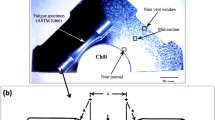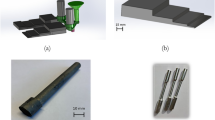Abstract
The influence of the casting filling technique and hot isostatic pressing (hipping) on the fatigue-life distribution of Al-7Si-Mg alloy castings has been studied. To vary the number density and size of oxide-film defects in the castings, test bars were cast using bottom-gated filling systems with and without filtration. Some unfiltered castings were subjected to a hipping treatment of 100 MPa at 500 °C for 6 hours. Test pieces were machined from the castings and were fatigue tested in pull-pull sinusoidal loading, at maximum stresses of 150 and 240 MPa under a stress ratio of R=+0.1. The fatigue lives at any probability of failure and Weibull statistical parameters of the filtered castings were higher than those of the unfiltered and nonhipped castings, illustrating the importance of the casting technique. However, the unfiltered but hipped castings exhibited higher performance. It is proposed that the significant improvement in fatigue life after hipping is due to the deactivation of entrained double oxide-film defects as fatigue-crack initiators.
Similar content being viewed by others
References
J. Campbell: Castings, Butterworth-Heinemann, Oxford, United Kingdom, 1991.
M.W. Ozelton, S.J. Mocarski, and P.G. Porter: “Durability and Damage Tolerance of Aluminium Castings,” WL-TR-91-4111, 1991.
G.R. Wakefield and R.M. Sharp: J. Mater. Sci. Technol., 1996, vol. 12, pp. 518–22.
G.R. Wakefield and R.M. Sharp: J. Mater. Sci. Technol., 1992, vol. 8, pp. 1125–29.
C. Nyahumwa, N.R. Green, and J. Campbell: AFS Trans, 106 (1998) pp. 215–23.
G.V. Scarich: 28th Nat. SAMPE Symp., Apr. 12–14, 1983, pp. 1329–39.
N.R. Green and J. Campbell: AFS Trans., 102 (1994), pp. 341–47.
W. Weibull: J. Appl. Mech., 18 (1951), pp. 293–97.
A. Khalili and K. Kromp: J. Mater. Sci., 26 (1991), pp. 6741–52.
A. Sunwoo and R. Lum: Scripta Metall. Mater., 33(4) (1995), pp. 639–44.
W. Thiele: Aluminium (Germany), 1962, vol. 38, pp. 707–15 and 780–86.
S. Impey, D.J. Stephenson, and J.R. Nicholls: Proc. 2nd Int. Conf., Microscopy of Oxidation 2, Selwyn College, University of Cambridge, Cambridge, United Kingdom, Mar. 29–31, Inst. of Materials, U.K., 1993, pp. 323–37.
M. Divandari and J. Campbell: 1st Int. Conf. on Gating Filling and Feeding of Aluminum Alloys, AFS, Nashville, TN, 1999.
Author information
Authors and Affiliations
Rights and permissions
About this article
Cite this article
Nayhumwa, C., Green, N.R. & Campbell, J. Influence of casting technique and hot isostatic pressing on the fatigue of an Al-7Si-Mg alloy. Metall Mater Trans A 32, 349–358 (2001). https://doi.org/10.1007/s11661-001-0266-8
Received:
Issue Date:
DOI: https://doi.org/10.1007/s11661-001-0266-8




